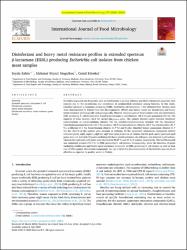| dc.description.abstract | Biocidal compounds are frequently used as disinfectants in poultry industry and their widespread usage has risen
concern due to the co-selection and persistence of antimicrobial resistance among bacteria. In this study,
extended spectrum β-lactamase producing (ESBL) Escherichia coli isolates (n = 60) obtained from chicken meat
were characterized by Pulsed Field Gel Electrophoresis (PFGE) and further tested for disinfectant and heavy
metal resistance phenotypically and genotypically. Plasmid replicon types of these isolates were also determined.
ESBL producing E. coli isolates were found to be resistant to ciprofloxacin (48.3 %) and gentamicin (15 %). The
majority of these isolates (46.5 %) carried blaCTX-M-55 gene. The isolates showed higher minimal inhibitory
concentrations to cetylpyridinium chloride (90 %), cetyltrimethylammonium bromide (50 %), hexadecyltrimethylammonium
bromide (46.7 %), triclosan (38.3 %), benzalkonium chloride (28.3 %), chlorhexidine (21.7
%), acriflavine (3.3 %), benzethonium chloride (1.7 %) and N-alkyl dimethyl benzyl ammonium chloride (1.7
%), but 18.3 % of the isolates were resistant to triclosan. Of the quaternary ammonium compounds (QACs)
tolerance genes, mdfA, sugE(c), ydgE and ydgF were most present in all isolates, but the qacE, qacG, oqxA and oqxB
genes were not detected. Of genes mediating the heavy metal resistance, the zitB gene was detected in all isolates,
whereas the copA and cueO genes were detected in 96.67 % and 95 % of isolates, respectively. The IncFIB plasmid
was commonly present (93.3 %) in ESBL producing E. coli isolates. Consequently, given the detection of genes
mediating disinfectant and heavy metal resistance commonly in ESBL producing E. coli isolates as well as high
rate of MICs against disinfectant compounds, the use of QACs for decontamination of the facilities may not be as
effective as expected in poultry sector in Turkey. | tr |















